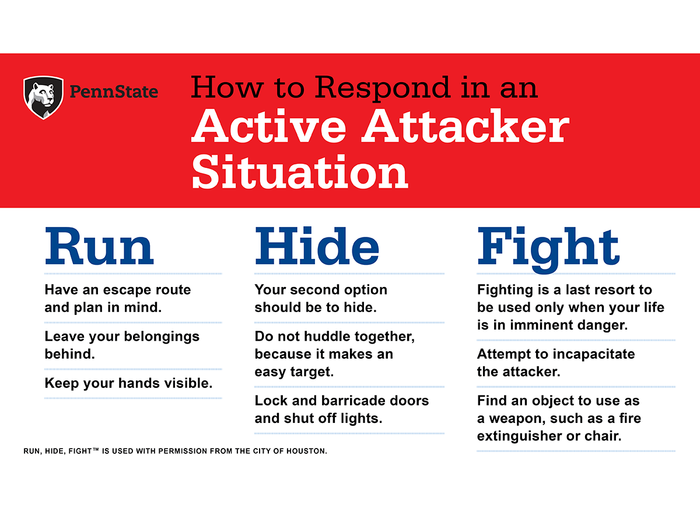
Penn State’s Active Attacker Response Program offers three action steps if confronted with an active assailant, making it easy to remember and act upon in an emergency: run if you can, hide if you can’t, and fight as a last resort. Once in a safe place, call 911 and give detailed information about what is happening.
UNIVERSITY PARK, Pa. — Penn State University Police and Public Safety is reminding all students, employees and visitors to familiarize themselves with the University’s official Active Attacker Response Program, to learn more about how to react when encountering a potentially life-threatening situation in any environment.
Based on the Run, Hide, Fight model developed by the city of Houston, Texas, Penn State’s Active Attacker Response Program offers the same three action steps if confronted with an active assailant, making it easy to remember and act upon in an emergency: run if you can, hide if you can’t, and fight as a last resort.
“We encourage individuals to plan ahead and have a strategy in mind if they are ever confronted with an active attacker,” said Wesley Sheets, Penn State’s interim chief of police and public safety. “Seconds absolutely count, especially in the first crucial moments while police are responding to the scene. Being able to think clearly and act quickly and decisively are vital if faced with such an emergency. This training provides the members of our community with the tools necessary to make these critical decisions, which is why Run, Hide, Fight is such an effective model.”
The Run, Hide, Fight concept is endorsed at the local, state and federal levels, including by the U.S. Department of Homeland Security and the FBI. University Police and Public Safety routinely offers Active Attacker Response Program training to campus groups, and training can be requested on the University Police and Public Safety website.
University Police and Public Safety has robust policies and procedures in place for active-attacker situations, and Penn State police officers train regularly for such potential circumstances. However, it is important that community members take the time to familiarize themselves with the Active Attacker Response Program, as it is designed to provide options to help survive an attack before police arrive.
Depending on individual circumstances, it is important to note that the run, hide and fight action steps may not always occur in that exact order, so memorizing them all as possible options, regardless of order, is urged.
Beyond the program’s namesake actions, University Police provides the following additional guidance to community members on what to do during each step in the process:
Run
- Have an escape route and plan in mind.
- Make sure it is safe to leave the area. Use your eyes and ears to determine if it is safe to run.
- Leave your belongings behind.
- Keep your hands visible.
- Once in a safe place, call 911 and give detailed information about what is happening. Don’t assume someone else has already called the police.
Hide
- If unable to run from the danger, your second option should be to hide.
- Find a place that’s out of the attacker’s sight and remain quiet.
- Do not huddle together, as this creates an easier target.
- Lock and barricade doors with whatever is available, such as desks, chairs or door wedges. Shut off lights.
Fight
- Fighting is a last resort to be used only when your life is in imminent danger. However, sometimes fighting may be the first and only option.
- Find an object to use as a weapon, such as a fire extinguisher, backpack, book or chair.
- Attempt to incapacitate the attacker; commit to your actions; work with others to disable the assailant.
In addition to familiarizing themselves with the Run, Hide, Fight model, University Police and Public Safety encourages community members to stay vigilant and pay attention to their surroundings, recognize the signs of suspicious activity, and contact law enforcement immediately if something doesn’t seem quite right. In short, if you see something, say something.
All students, faculty and staff also should sign up for PSUAlert text messages to stay well-informed of the latest emergency information from the University.
In the event of any report of an active shooter or attacker, a rapid response by law enforcement to the scene and communication to the community by email, text, telephone and social media using the University’s PSUAlert system would occur. Initial alert messages would be followed by critical information and regular updates.
All Penn State students and employees with a Penn State email address automatically receive PSUAlerts by email. Students and employees are encouraged to visit psualert.psu.edu to update their settings so that they receive PSUAlerts by text message and/or phone call as well. Users also can choose to receive alerts for multiple Penn State campuses. In the event of an emergency, PSUAlert will be used to provide the campus community with critical information.
Employees who may find it difficult to review such subject matter or take part in the trainings offered by University Police can seek support through the Employee Assistance Program. Students at University Park can find support through Counseling and Psychological Services. Students at other Penn State campuses can find support here.
Click here to report suspicious activity or a crime on any Penn State campus. In an emergency, always call 911.






